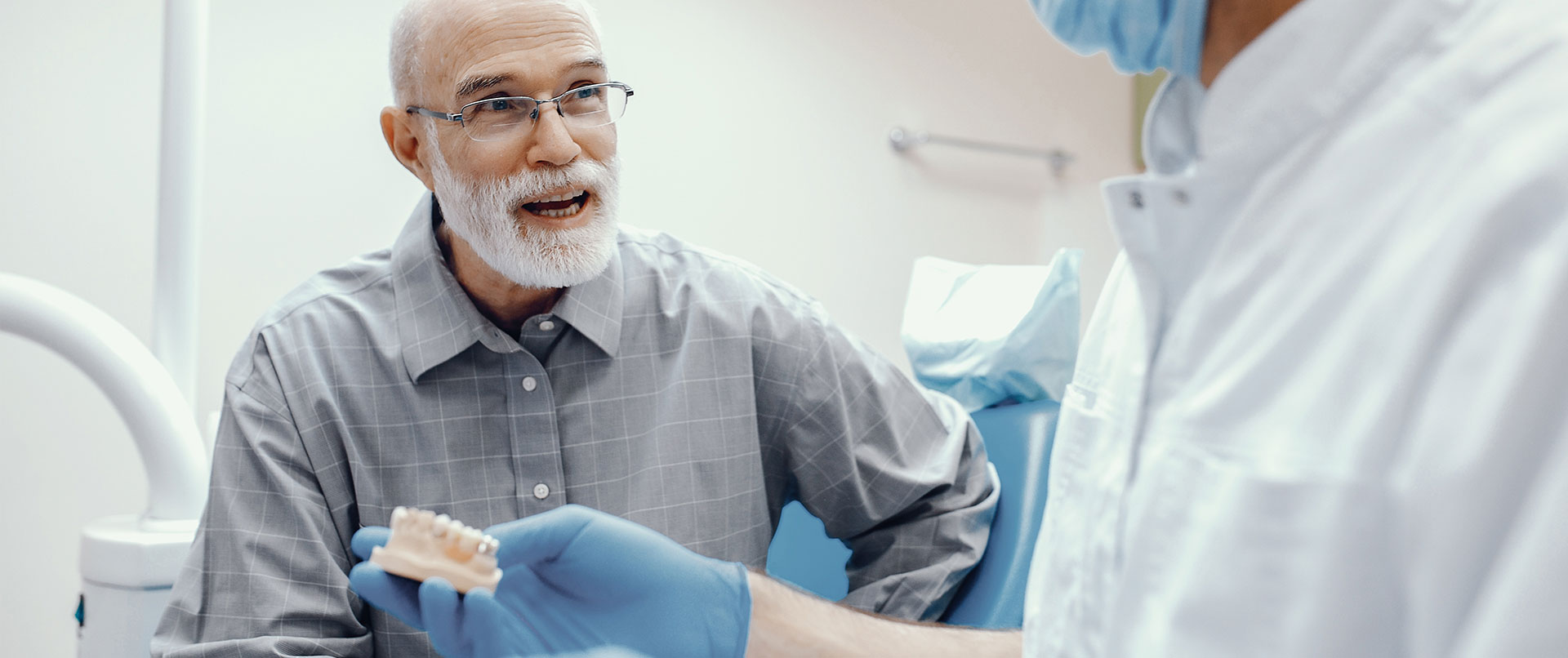Benefits Explained
What are all on four implants?
All on four dental implants are also sometimes referred to as full mouth dental implants. Essentially this refers to an implant bridge (a full set of artificial teeth) that is fixed onto a minimum of four implants screws – thus the term ‘all on four'. The implant bridge may replace an entire arch or in some cases both arches.


DENTAL IMPLANTS
Why choose full mouth dental implants?
A large proportion of our patients who choose to have all on four implant treatment are denture wearers who struggle to adjust to their dentures or who have had to struggle with missing/failing teeth for many years. These struggles can have a huge impact on a person’s physical and mental wellbeing.
Our patients who have experienced these struggles have reported that they have become more isolated over the years due to feeling embarrassed to socialise with their loved ones & friends and their quality of life have generally deteriorated.
Opting for all on four dental implants may remove these struggles and improve your quality of life so that you may eat, drink and socialise as before.

DENTAL IMPLANTS
What is the process & how long does it take?
All on four dental implants can be done using two different approaches; a delayed loading approach or the teeth-in-a-day approach. Both of these approaches will involve several steps and may differ from patient to patient depending on their current dental health and needs.
Delayed loading approach:
Delayed loading means that there is a waiting/healing period between placement of the implants and receiving the final implant bridge. There are generally three main components involved:
• The implants – which look like screws, are placed into your jaw. The implant screws are then left for 3 – 6 months to fully integrate with your jaw to form anchors for your new set of teeth. During the healing time, temporary healing caps will be placed over the implant screw to seal off the implant screw. It may be possible for temporary teeth to be worn over the implant site. This option will be discussed by our implant dentist prior to the implant surgery. In some cases, bone grafting and/or a sinus lift is also needed for the implant placement to be successful.
• The abutments – after the initial healing period of the implant screw surgery, the implant screws are uncovered, the temporary healing caps (or the temporary teeth) are removed and abutments are placed on each implant screw. Your gums will be allowed to heal for a minimum of two weeks following this procedure. (please add a picture of abutment)
• The artificial teeth (bridge) – finally the full bridge(s) created to replace your natural teeth will be attached to the abutments. An implant bridge is currently the closest replication you can get to your natural teeth. They very much look and function like natural teeth. After a short time, you will experience restored confidence in your smile and ability to chew and speak normally.

Teeth-in-a-day approach:
There is no delay in placement of the implants and receiving the bridge. This approach is not suitable for everyone and will only be considered if you qualify. The components & process involved differs slightly from the delayed approach:
• Preliminary workup – patient is seen for impressions to fabricate the temporary implant bridge and all other necessary check-ups/scans/X-rays are completed. This may take place over more than one appointment.
• The implants & abutments – once the bridge is received, the patient comes in for the implant surgery. Instead of getting temporary caps or teeth, the abutments is immediately placed onto the implants.
• The temporary bridge - next the temporary bridge is fixed onto the abutments & implants on the same day. The whole procedure can take half a day or up to a full day.
The healing time for the implants to fuse with the bone is also 3-6 months but the difference is that a temporary bridge is attached to the implants while healing. After the implants have integrated into the bone, the temporary bridge is replaced with the permanent implant bridge.

DENTAL IMPLANTS
Who is suitable for all on four treatment?
• Patients who have missing or failing teeth
• Patients who has been provided with dentures as the only viable option
• Patients who would like to replace their dentures
• Patients who have not has been told that they do not have enough bone present to offer a solution
• When tooth loss is inevitable
• Patients who have gone through extensive dental work in the past such as crowns and traditional bridges that are now failing.
• Patients with chronic gum disease.
What are the main benefits of all on four dental implants?
• It is a permanent solution for restoring missing teeth
• All on four implants are designed to be long lasting
• All on four implants cost less than individual replacements for all of your teeth
Book Your Free Consultation.
A Perfect Fit
Werner Slabbert and Jon Dolding describe how a simple, accurate and stable full arch implant-supported prosthesis changed a patient’s life overnight


